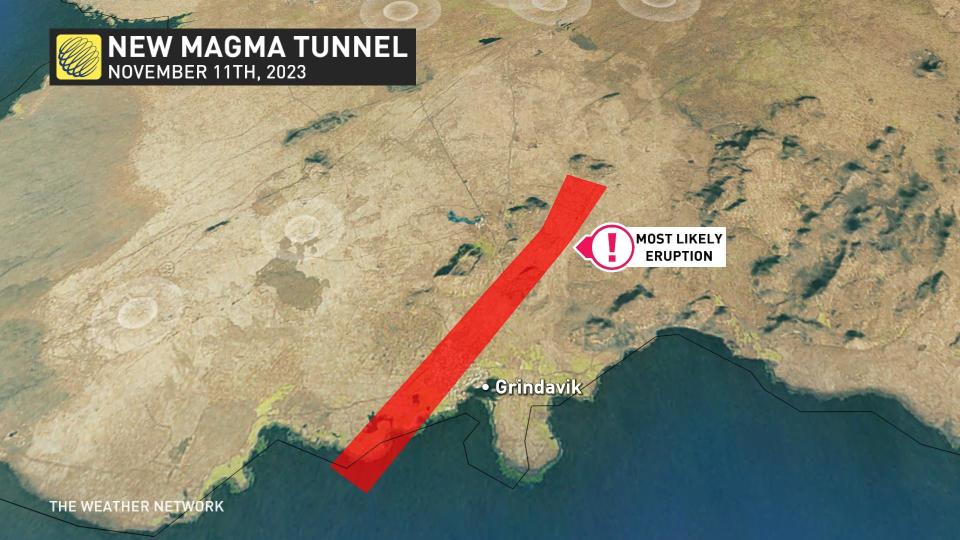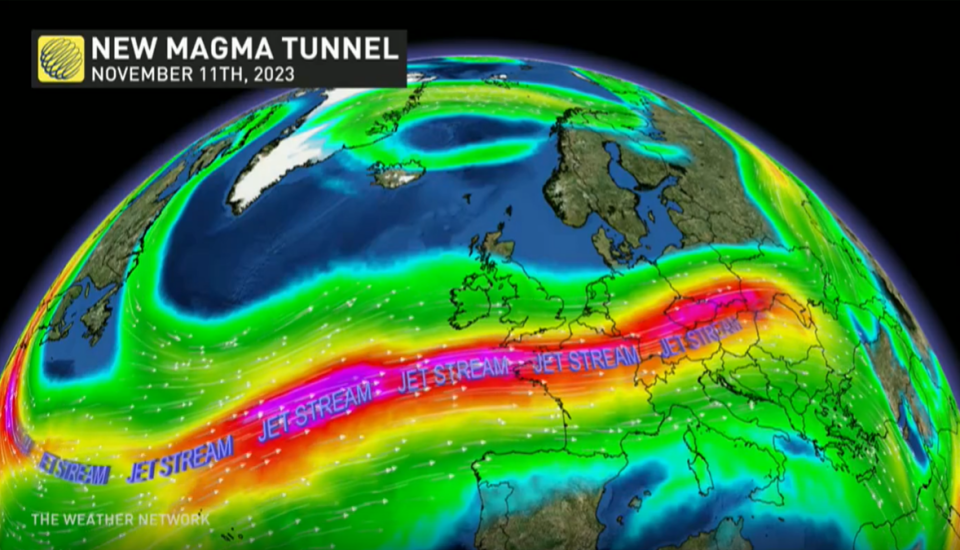Iceland’s rumbling volcano could affect Canadian flights, commerce
Officials are concerned that a volcanic eruption is imminent in southwestern Iceland after a vast pool of magma just beneath the surface has triggered thousands of earthquakes and heaved the ground throughout the region.
If this magma breaches the surface, the ensuing eruption could have consequences for travel and commerce between North America and Europe in the days and weeks to come.
READ MORE: Iceland evacuates town over concerns of volcanic eruption

We’ve seen thousands of jolting earthquakes beneath Iceland’s Reykjanes Peninsula since Thursday, November 9, with more than 350 of the quakes coming in at magnitude 3.0 or stronger.
This intense earthquake swarm is the result of a significant pool of magma travelling under the peninsula, breaking rocks and causing large heaves and cracks on the surface as it moves.
The earthquakes last night make a lot of sense when you see this. These photos from the town of Grindavik and it's golf course reveal the ground deformation as a result of the powerful swarm. The power of magma looking for a way to the surface.Source: https://t.co/0tuyyrNxIF pic.twitter.com/zFhhtbESJv
The earthquakes last night make a lot of sense when you see this. These photos from the town of Grindavik and it's golf course reveal the ground deformation as a result of the powerful swarm. The power of magma looking for a way to the surface.
Source: Alex Spahn 🌋🌪️☄️ on Twitter: "The earthquakes last night make a lot of sense when you see this. These photos from the town of Grindavik and it's golf course reveal the ground deformation as a result of the powerful swarm. The power of magma looking for a way to the surface.Source: https://t.co/0tuyyrNxIF pic.twitter.com/zFhhtbESJv / Twitter" Alex Spahn 🌋🌪️☄️ on Twitter: "The earthquakes last night make a lot of sense when you see this. These photos from the town of Grindavik and it's golf course reveal the ground deformation as a result of the powerful swarm. The power of magma looking for a way to the surface.Source: https://t.co/0tuyyrNxIF pic.twitter.com/zFhhtbESJv / Twitter"
Given the sharp uptick in seismic activity, the shallow depth of the quakes, and increased surface damage, officials are concerned that an eruption in or near Grindavík is imminent.
The effects of an eruption could spread far from Iceland.
An explosive eruption is possible
Iceland's many volcanoes are in a near-constant state of activity. Most of the island’s volcanic activity rates low on the Volcanic Explosivity Index, stemming from fissure eruptions that gradually spew lava without a major explosion.
“The overall assessment from the status meeting was that the likelihood of a volcanic eruption is high, and that an eruption could be possible on a timescale of just days,” the Icelandic Meteorological Office said in a statement issued Saturday evening.
WATCH: Will Canada use volcanoes to generate energy?
Ash becomes a major hazard if magma breaches underwater
Data from seismographs showed that the magma began to move beneath the ocean just off the Reykjanes Peninsula on Saturday, which could increase the chance of an explosive eruption if magma breaks through to the surface.

While ash and noxious gasses may pose a hazard from a land-based eruption, the risk grows significantly if an eruption occurs beneath the ocean instead.
Magma’s heat can easily exceed 1,000°C as it erupts from the ground as lava. If this breach happens underwater, the extreme heat instantly boils the water right around the lava.
The ensuing steam explosion breaks the lava apart, creating even more steam and ash that violently spews out of the ocean and into the atmosphere.
An underwater eruption could disrupt global commerce, travel
If this eruption occurs and spews a large amount of ash and gasses into the atmosphere, we might see international consequences over the coming days and weeks.
Ash is such a lethal threat to airplanes that no pilot or airline would risk flying through or even near it. Volcanic ash consists of microscopic rocks, minerals, and glass vented into the atmosphere by an eruption.

Volcanic ash and jet engines don’t get along. The abrasive particles damage fan blades, harden inside the superheated engine, and clog up the engine’s compressor, all of which can cause the engine to seize up and fail. That’s dangerous no matter the circumstances, but especially for flights over the open ocean.
As a result, any significant intrusion of ash into the atmosphere over Iceland could significantly affect passenger and cargo traffic between North America and Europe.
The jet stream will remain far south of Iceland for the next couple of days. However, if it begins to shift closer to the island, any potential ash migrating over Europe would affect local air travel on the continent as well.
Ash and steam from a potential eruption could also affect the weather itself by cooling and warming the atmosphere, respectively, though it would take a formidable amount of both to have global effects. Billowing clouds of ash can also produce intense lightning right around the site of the eruption.
Recent history shows disruptive underwater volcanic eruptions
We have some recent precedent for volcanic eruptions involving water.
Many of us are familiar with Iceland’s volcanoes after the mid-2010 eruptions of Eyjafjallajökull. This event began as a fissure eruption, but glacier meltwater seeping into the vent caused an explosive eruption that spewed a tremendous amount of ash into the atmosphere.
MUST SEE: Tonga volcano eruption was so violent it blew ash halfway to space
Eyjafjallajökull’s ash cloud followed the jet stream into Europe, shuttering much of the continent’s airspace for nearly a week and severely affecting international travel.
There’s also the case of Hunga Tonga-Hunga Ha’apai, the mammoth underwater volcanic eruption near Tonga in January 2022. Any eruption in Iceland wouldn’t come close to the power of this high-end event.
Hunga Tonga produced an explosive volcanic eruption and a steam explosion wrapped into one. The eruption generated lethal tsunamis, sent a pressure wave circling the Earth several times, and belched a tremendous amount of ash and steam into the atmosphere.
Header image of the nearby Fagradalsfjall eruption in 2021 taken by Björn Oddsson, courtesy of Iceland’s FUTUREVOLC project.

